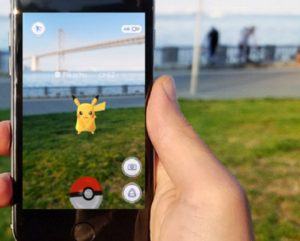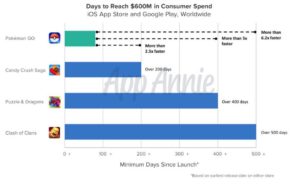Niantic Labs and Pokemon Go: Bringing AR to the Masses

“Gotta catch em all” no longer means playing cards at recess. Niantic brings this trip down memory lane into the 21st century with augmented reality.
Remember trading Pokemon cards with your friends on the playground in the 90s, or sitting in your elementary school cafeteria collecting these mythical creatures? We’ve all grown up and entered the 21st century – and so has Pokemon!
Niantic Labs, a software development company founded in 2010 with the express purpose of focusing on augmented reality, brought our childhood dreams to fruition. The company was originally founded as a part of Google, but spun out in 2015 after raising $25 million from Nintendo. Niantic launched Pokemon Go in the summer of 2016, after developing the product for over two years in conjunction with Nintendo. The product, which encourages users to use the app to spot Pokemon in the wilds of their own surroundings, uses augmented reality to overlay the animated creatures onto your current setting by using a mobile device.
The product was an overnight success in the most literal form: the app was most downloaded application on the iOS app store and the Google Play Store within a few days, and generated over 500 million downloads within the first 90 days. More impressive, in the 6 months since the application launched until the end of 2016, Pokemon Go generated almost $950 million for the company. It was 6x faster to grow to the $600 million revenue mark than its closest rival: King Digital’s CandyCrush Saga, which took 200 days versus Niantic’s 90 days. The growth numbers were staggering for Pokemon Go.
Value Capture from Mainstream AR
So how does Pokemon Go capture value? The company sells “virtual goods,” a phenomenon that has taken off in the world of livestreaming and gaming over the last few years. Users can purchase Pokeballs or coins to help uplevel them, unlocking additional functionality for players and making the game more enjoyable as a result. Furthermore, Niantic has toyed with the possibility of allowing businesses to pay to get Pokemon in or near their stores for increased foot traffic. The company creates value by tapping into the nostalgia of former Pokemon players to test mobile AR, encouraging users to continue using the product and generating geographic datapoints by unlocking increasing functions with more animals collected.
But Pokemon has had an unceremonious fall from grace. Over the past few months, usage has dropped substantially as the “try anything” userbase has dropped off. Daily revenue fell from a high of $16 million to $2 million, and daily usage decreased from 27 million to 700k. While the augmented reality aspect of the game brought AR into the mainstream, the company has had trouble differentiating Pokemon from other mobile games. Users complained that while the AR component originally piqued their interest, the game itself is shallow.
Going Back to Basics
While augmented reality sparked a ton of initial interest, the game has not proven to be particularly fun for users. Despite claimed health benefits of exercising slightly more, users failed to see the benefit of walking around collecting virtual, animated objects. But it’s not too late to salvage Pokemon Go. Niantic should double down on its content creation: adding new augmented reality elements to the game to attract users in a sustained fashion that serves as a point of differentiation. Nostalgia alone does not retain users, and while mobile gaming attracts a large audience, the mainstream userbase Niantic is targeting demands more creative content that leverages AR.
Another major opportunity for Niantic is to focus on the social elements of augmented reality. As Facebook demonstrated this week in its F8 conference, the future of these technologies is inherently social. Pokemon Go lends itself naturally to a social environment – collecting creatures, Pokeball training or sharing tips with connections is an interesting use of the technology that encourages people to keep coming back to the platform. As it stands, Pokemon’s technology and business have no network effects, but a social component could encourage users to stay in the game for longer.
Niantic has opened up the floodgates for mobile AR, and reached demographics these games ordinarily would not. Their initial efforts have been commendable, but they need to focus on content and social interaction in order to enhance the technology and value capture opportunities. Niantic’s foray into AR through Pokemon go leads to the conclusion that in some instances, the medium is not necessarily the message. Just because they developed interesting and unique technological advances did not necessarily mean that content had to take a back seat – something other AR and VR content developers should take heed.
Finally, Niantic has a bigger scope than simply Pokemon Go. The company has developed a game called Ingress, and will likely continue to expand in the AR gaming universe. Instead of becoming the next Electronic Arts (a fate that many would be fine with!), Niantic should consider becoming a platform on which anyone who wants to develop AR games turns. If they can become the de facto SDK for AR gaming, they can add a lot more value by taking advantage of scaling content beyond the walls of the company. A value capture through revenue sharing will go a long way if the company develops an API on which all AR game developers build. By shifting from a product focus to a platform focus, Niantic can capitalize on its successes (and learnings) from Pokemon Go.
Sources:
- https://techcrunch.com/gallery/a-brief-history-of-niantic-labs-the-makers-of-pokemon-go/
- https://www.crunchbase.com/organization/nianticlabs-google#/entity
- https://blogs.wsj.com/digits/2015/09/10/pokemon-go-wants-to-take-monster-battles-to-the-street/
- https://venturebeat.com/2016/10/20/pokemon-go-is-the-fastest-mobile-game-to-hit-600-million-in-revenues/
- http://www.marketwatch.com/story/how-pokemon-go-makes-money-2016-07-11
- http://theconversation.com/what-went-wrong-with-pokemon-go-three-lessons-from-its-plummeting-player-numbers-67135
- https://www.nianticlabs.com/blog/
- https://www.businessinsider.com.au/pokemon-go-niantic-labs-ruining-the-game-2016-10




Great post, Ellen. Interesting idea to have Niantic become a platform for AR game development with its own SDK– I do wonder how technically challenging it is for developers to launch a similar game. Do you think Niantic could bring enough value to the developer community to serve as a platform? My gut is that they may be best served becoming the best-in-class AR mobile developer (to your EA point), but I would be curious to see if they could do some sort of platform play.
Love the idea of a social component that helps encourage users to stay in the game for longer. I think they tried to bake an early form of this into the original product with the Lure Module that people could use at a Pokestop to increase spawn rates thereby keeping you at the Pokestop longer and also drawing more people to a given Pokestop (not that I have ever used Pokemon Go myself…). Social + these types of retention tactics = network effects, which play into the current sponsorship business model.
Gotta catch ’em all!
Great post. I remember seeing to many people wandering around with the their smartphones out when this app was first released looking for Pokemon! It makes me wonder how much of the allure of AR/VR is mostly about novelty rather than genuine value to the consumer, and whether a lot of AR applications will experience extreme peaks in demand that then fall off sharply, especially early on in the development of the technology. It seems like the AR/VR revolution is has been just around the corner for years now!
I’m glad someone wrote a post about this! I’m not going to lie, I spent a lot of my summer wandering around looking for rare Pokemon. There have been a lot of discussions about why Pokemon GO was so successful and, reflecting on my other childhood, I can’t help but wonder if it was more a reflection of the strength of the Pokemon IP or the interactive AR component of the game. Regardless, while the initially virality has faded, Pokemon GO was a great demonstration of the potential of VR/AR gaming coming into the mainstream.
Great post and certainly one of the biggest proven use cases of this technology thus far. Though the rise and fall of this game were rocky, I think the decline shouldn’t be seen as a failure. $3MM and 700k users aren’t bad at all, especially for an emerging category! I also wonder how much of the decline was a result of the fact that we may just be tired of Pokemon after years of use? I’ll be excited to see what Niantic can do after the Pokemon game, as I am guessing that Pokemon Go gave them lots of interesting data on the usage of AR on mobile phones that literally no one else has, 2nd closest may be Snap’s collected info of people using their AR filters.
Great post Ellen! As someone who was baffled by the popularity of Pokemon Go, I found it really helpful to understand why it was such an instant success as well as the pitfalls the company is now enduring. I wonder how advances in VR technology will change the functionality of games like these – do you think it will be harder to maintain the ‘social’ aspect if you are behind a headset vs. just a phone?
Thanks for the awesome post!
Glad you wrote about this Ellen. One line resonated particularly: “users complained that while the AR component originally piqued their interest, the game itself is shallow.” I fall totally in this camp. Having become curious about the “light AR” implementation, I tried out the game only to find that it’s not challenging enough. At some point you realize it is just a grind consisting of (a) walking around and (b) swiping up a lot to catch these creatures. I really hope Niantic recognizes what made this game special (the overlay on real maps and real camera footage), and uses this as the foundation for more games going forward. If they can recycle these components effectively, the decline in Pokemon Go users does not have to be the downfall of the company itself.
Pokemon GO was definitely a game changer for AR. Even though the game has fallen from grace, as you mentioned, I think they learned a lot and paved the way for broad acceptance of AR as a technology people can actually understand and use on their own – even if it is at a very basic level. I hope that they come back with a more in depth version of the game!
Great post! It is crazy how quickly usage can skyrocket and decrease with these fad games. I would assume it makes advertising partnerships harder to construct and turn around during such a short period. It would be cool if the platform you suggested allowed advertisers to hook into multiple games easily in one place.
Great post, Ellen! Based on what I know, it would be really interesting for Niantic to leverage its Ingress / Pokemon Go AR platform to extend to other IP. I think they should consider partnership opportunities with entertainment brands to use its AR platform to create unique games, especially ahead of major releases of films and TV shows. For instance, how cool would it be to have a Wizarding World AR game developed by Niantic for Fantastic Beasts? Given that there are likely going to be five Fantastic Beasts films, the game could potentially have longer legs than a Pokemon game, especially if it is updated frequently with new content.
Great post, Ellen! I think this is the story with most mobile/casual games that they capture most of their value in the initial launch period when people are willing to try new things and then drop off. There is nothing specific about an AR game about being drop off higher, rather as you mentioned they grew super fast. It will be exciting to see what they have in store next!